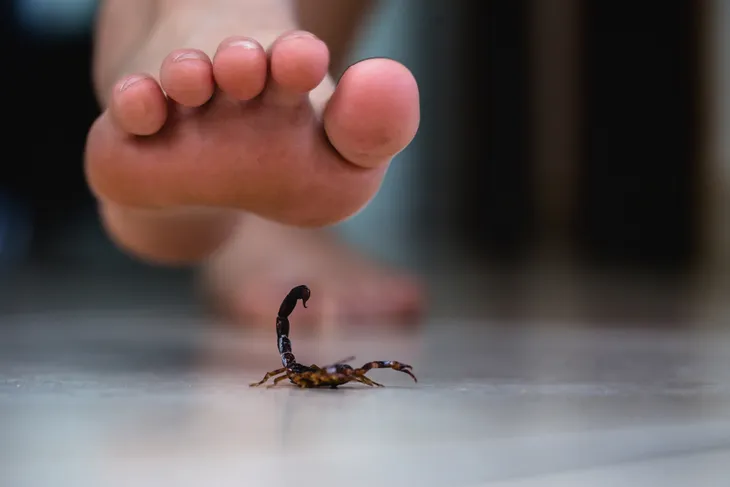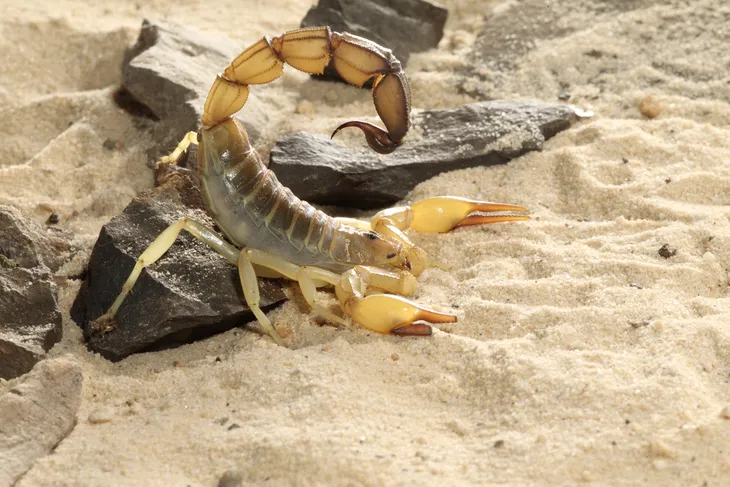- There are roughly 2,000 scorpion species worldwide but only 30 to 40 have strong enough venom to be life-threatening to humans.
- Scorpions sting when they feel threatened.
- While most scorpion stings don’t require medical treatment, some can be a medical emergency.
- Know the severe symptoms of a scorpion sting and seek medical attention if they develop.
Some creatures are lurking around that can put your health at risk. One of those creatures is scorpions. Scorpions are predatory arachnids that have eight legs, a distinct curved tail tipped with a venomous stinger, and two pincers at the front.
There are roughly 2,000 scorpion species worldwide but the National Geographic says only 30 to 40 have strong enough venom to be life-threatening to humans. And one of those species lives in America. To protect your health, it’s important to find out which scorpions are prevalent where you live or where you plan on traveling to. Knowing what they look like, where they thrive, and what to do if you’re stung is vital in protecting your health. Here’s what you need to know about scorpion stings!
Why Do Scorpions Sting?
Scorpions are found in many types of habitats but they prefer deserts and semi-arid regions. While they often hide under logs and rocks, they can also be found in crevices of your home or under piles of firewood and clutter. Scorpions aren’t usually aggressive but they will sting when they feel threatened or are provoked.
The stinger is located on the scorpion’s tail. When they sting they inject venom into your body that contains a mix of toxins that can affect your nervous system, explains the Mayo Clinic.
Who’s At Risk?
Certain factors can increase your risk for scorpion stings, such as where you live. Scorpions don’t live everywhere but the Mayo Clinic says in the U.S. they’re prevalent in the desert Southwest, including Arizona, New Mexico, and some parts of California. They’re also prevalent in other areas of the world including Mexico, North Africa, South America, India, and the Middle East.
Certain activities can also increase your risk of scorpion stings such as hiking or camping in areas where scorpions live. That doesn’t mean you need to forgo these activities altogether, you should just be aware and take extra precautions.
Finally, the source says you can also increase your risk by traveling to places where scorpions live. More dangerous species also live in other parts of the world so it’s important to do your research and find out which types are common in the place you’re traveling to.
Are All Scorpions Dangerous?
While there are over 1,000 species of scorpions, only about 30 in the world produce venom that is toxic enough to be lethal to humans, according to the Mayo Clinic. And some of them aren’t even lethal to healthy adults but they can still cause severe symptoms. Young children and seniors are the most at risk.
Lethal scorpions have a venom that’s packed with neurotoxins. When these neurotoxins enter your body they cause severe pain. In severe cases, it can cause more serious symptoms, and sometimes it can be fatal. Let’s take a look at some of the most dangerous scorpions next.
Bark Scorpion
The bark scorpion is the most venomous scorpion in the U.S. According to the American Outdoor Guide, this species is commonly found in Arizona but it has also been spotted in New Mexico, southern Utah, and southern Nevada.
The bark scorpion has a slender body, a thinner tail, and thinner pincers compared to some other types. They’re about 3-inches large and range in color from tan to a yellowish brown and sometimes have stripes running from their head to tail. The source says another unique trait is it will lay its tail flat and cocked to its side when ambushing prey. They typically prey on roaches and other small insects but they can sting humans if they’re provoked.
The bark scorpion doesn’t make burrows, instead, they like to hide in small places like wood and rock piles, or in tiny crevices in your home like cracks in the walls or furniture. According to Medical News Today, 85-percent of bark scorpion stings cause mild reactions, while 10-percent cause painful symptoms, and 5-percent cause serious symptoms.
Spitting Thick-Tail Black Scorpion
The American Outdoor Guide says the spitting thick-tail black scorpion, also known as the South African fat-tail scorpion, is one of the largest scorpions, growing to about 6-inches in length. It’s also the most venomous in the southern regions of Africa. Their stinger can inject 4.25-milligrams of venom which is enough to be fatal to a human. That said not every sting is immediately fatal. The source explains that the scorpion may give a “warning dose” and if the attacker doesn’t back off it may sting with a second dose that is lethal.
This scorpion is usually black in color and has a very thick tail, hence the name! Another unique trait of this scorpion is it can spit venom up to 3-feet away and it can make a warning sound (like a rattlesnake) by rubbing its stinger across its back. Like other scorpions, they like to hide under rocks, in cacti, and in other crevices that can get them out of the hot desert sun.
Yellow Fat-Tail Scorpion
The American Outdoor Guide says the yellow fat-tail scorpion has “one of the most powerful neurotoxins found in scorpions.” It’s fast-acting and can attack the central nervous system causing paralysis. It can even be fatal if not treated within 2- to 7-hours.
The yellow fat-tail scorpion has a thin body and small pincers and is about 2.5- to 3.5-inches long. The body is typically a dark shade of brown or black with darker horizontal stripes while its legs, pincers, and tail are bright yellow. So, where can you find these lethal scorpions? The source says they’re commonly found in North Africa and Southeast Asia.
What Is the Most Venomous Scorpion in the World?
According to the Guinness World Records, the deathstalker scorpion is the most venomous scorpion in the world. Its lethal venom is a cocktail of neurotoxins and cardiotoxins. They’re prevalent in the Middle East and North Africa.
Venom from this scorpion can cause a severe allergic reaction and excruciating pain. Some people even develop pancreatitis. But the American Outdoor Guide says the primary cause of fatality from their sting is pulmonary edema, which is a buildup of fluid in the lungs.
The deathstalker is a small scorpion that only grows to about 2.5-inches. They’re usually pale yellow with a faint black shadow on their head and body. If you’re stung by this venomous scorpion, the source suggests taking a photo to show the doctor and get immediate medical attention.
Common Signs and Symptoms of a Scorpion Sting
Healthline points out that most scorpion stings only cause localized symptoms. This means you may feel pain or warmth at the site of the sting. But the symptoms can be very intense, including intense pain, as well as swelling, tingling, or numbness around the sting. But that’s not all.
The Centers for Disease Control and Prevention (CDC) says other symptoms of a scorpion sting may include restlessness, convulsions, staggering gait, slurred speech, drooling, muscle twitches, abdominal pain or cramps, and respiratory depression. Some stings can even be fatal.
When to See a Doctor
Children and older adults should get immediate medical care if they’re stung by a scorpion. You should also get immediate care (even if you’re a healthy adult) if you’ve been stung by one of the most venomous scorpions.
If you’re not sure what type of scorpion stung you, try to take a photo to show the doctor and monitor your symptoms. Any severe symptoms require immediate medical attention.
How Are Scorpion Stings Diagnosed?
Your doctor can usually diagnose a scorpion sting by reviewing your symptoms and observing the site of the sting. However, the Mayo Clinic says if symptoms are severe your doctor may order a blood test and imaging tests to see how the venom has affected your organs like the heart and lungs.
Once a scorpion sting diagnosis is confirmed, your medical team will work swiftly to treat it. Let’s take a look at some of the treatment options next!
How Are Scorpion Stings Treated?
It’s important to remember there are thousands of scorpion species and only a small percentage pose a serious threat to your health. With that in mind, the Mayo Clinic says “most scorpion stings don’t need medical treatment.” Stings that don’t cause severe symptoms can be taken care of at home. The source suggests cleaning the site with mild soap and water. A cool compress and over-the-counter pain relievers can also help reduce pain.
But if you develop severe symptoms, you need to head to the hospital. Some scorpion stings can be a medical emergency. Severe stings may need to be treated with antivenom and you may also be given pain medication intravenously to help reduce your symptoms.
How to Prevent Scorpion Stings
No one wants to be stung by a scorpion but it can happen. Luckily, there are steps you can take to help prevent stings. If you live in an area where scorpions are common, the Mayo Clinic suggests cleaning up piles of rocks and wood around your house. It’s also a good idea to keep your grass closely mowed, trim overhanging trees, and prune bushes to prevent scorpions from entering your home.
Further, the source says you should also fill any cracks in your home, use screens on doors and windows, and install weather stripping on your doors and windows. When using gloves, boots, or clothing that hasn’t been used in a while, be sure to shake them out to ensure a scorpion isn’t residing inside. Finally, when you travel be sure to do your research and find out if you need to be aware of any lethal scorpions or other potentially harmful creatures.
Finally, the source also says that scorpions glow under black light. So bring one with you when you go camping to inspect your surroundings at night. If you find a scorpion, never pick it up with your hands. Instead, move it away with tongs.















